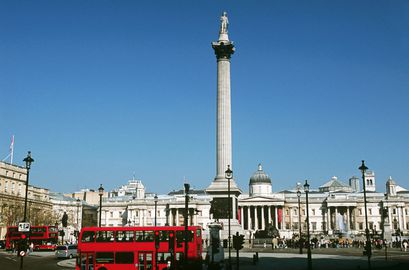

The entire area of Trafalgar Square was conceived as a national memorial to one single naval battle – the Battle of Trafalgar, off the Spanish coast. As you see, the square is filled with fountains, guarded by lion statues. The square is a favorite place to gather on New Year's Eve – bathing in the fountains is officially banned, but the Police take a generous approach on 31st December. Stand with your back to Nelson's Column, looking North. The enormous colonnaded building of the National Gallery fills the entire North side of the square. To the left of the Gallery you can see a modern building – the new wing of the gallery. Prince Charles was so angry about the design's place in Trafalgar Square that he called it "a carbuncle on the face of a well-loved friend". The building on the West side of the square is Canada House, which is both the Canadian Embassy and Canadian Cultural Centre. At your right you can see the church of St Martin-In-The-Fields to the right of the National Gallery, and commercial buildings occupying the East side of the square. From the Southern side of the square you can see three of London's largest streets, which all meet at Trafalgar Square. To the East, you see the street called Strand. "Strand" originally meant beach (and it still does in German) – in Roman days, the shallow slope down to the banks of the River Thames ran here, and you could walk along it. Across the very busy road here you see a street which has two official names – it's called both Whitehall, and Parliament Street. To the right of Whitehall you see a broad street closed off with large arched gates, through which traffic can still pass. This is the Mall, and it leads to Buckingham Palace.
Although Nelson repelled the French, his square was invaded by an airborne enemy in the 1960s and 1970s – pigeons. There are still quite a few, but forty years ago the square was filled with them – along with all the areas around it. Part of the problem was that tourists liked to feed the pigeons, and thought it brought them luck? The situation got hugely worse when the 1964 film "Mary Poppins" was released. It had a very sentimental song which encouraged people to "feed the birds – tuppence a bag". Tourists enthusiastically bought birdseed from sellers in the square, paid their tuppence – and encouraged the avian invasion. By the 1980s the situation was so terrible that the Mayor had to spend huge amounts, treating the facades, roofs and window-ledges of all the buildings around the square with chemicals to drive the birds away – and feeding the birds was strictly banned. Incidentally, at the film's premiere in 1964, a small lady was seen leaving the cinema, crying. It was Mrs P.L.Travers, the author of the "Mary Poppins" books – appalled at what the Disney corporation had done to her work. The cinema was on Leicester Square, just two minutes walk from here.
Amid the happy tourist atmosphere we see in Trafalgar Square today, it's easy to forget that it has also witnessed less pleasant scenes. In fact the original reason for adding the fountains to the square – back in 1839 – was to reduce the opportunities for political demonstrations. But soon after the fountains were opened, riots took place organised by the Chartists – a group campaigning for fair voting rights, and an end to Parliamentary seats being bought for cash. The result was a complete ban on all public meetings in the square. The most famous riots in Trafalgar Square happened in 1990, and again for political reasons – demonstrators gathered to oppose increased taxation on the poor, introduced by Mrs Margaret Thatcher, The Prime Minister of the United Kingdom from 1979 to 1990. For three days the Police failed to keep order, and the square became a battleground – shocked tourists stayed away from the area. Finally tear gas and baton charges were used to clear the protestors – but the political damage to Mrs Thatcher had been done.